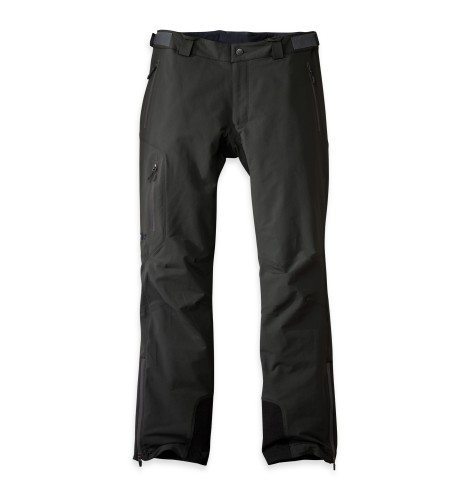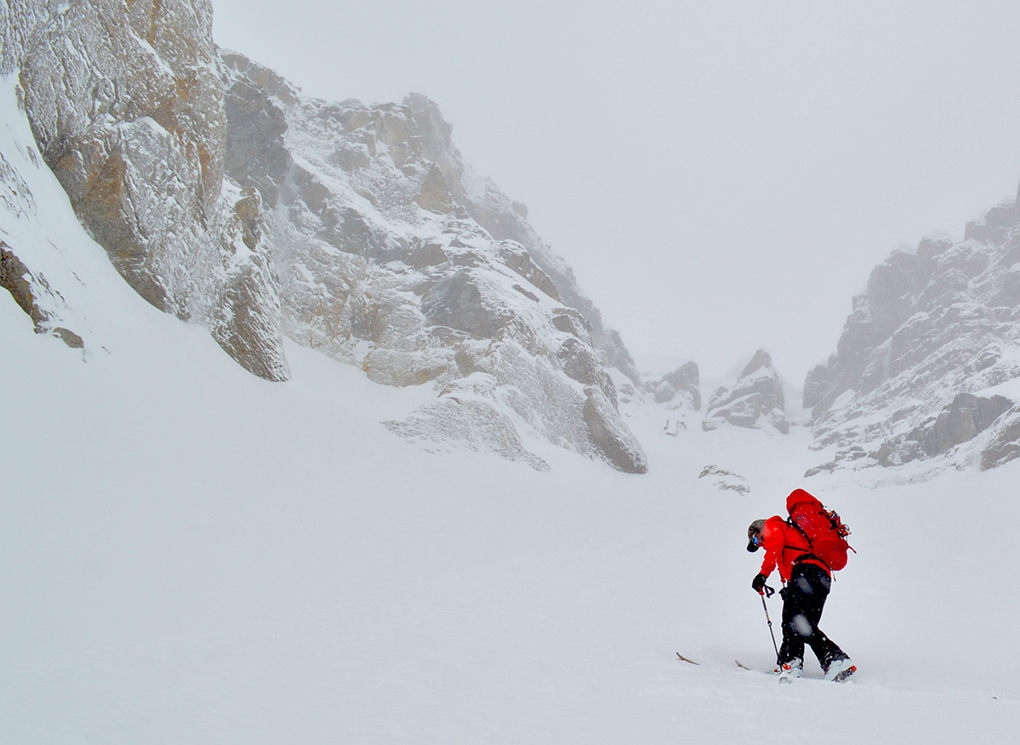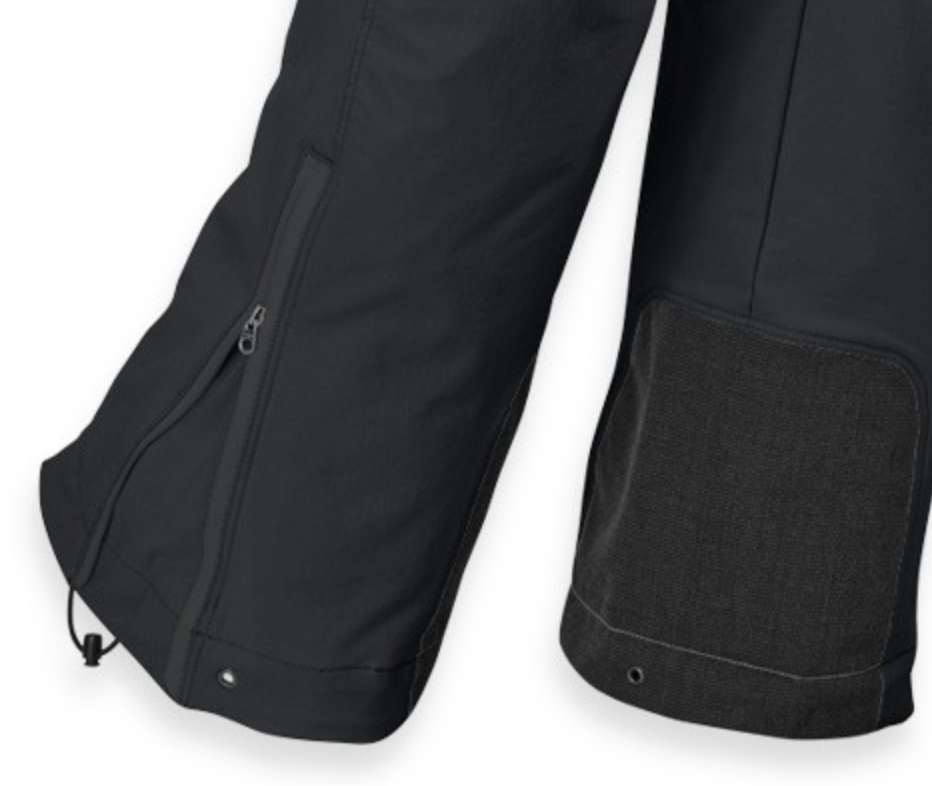
Outdoor Research Cirque Pants
Features:
- Movement-Mirroring Stretch
- Belt Loops
- Adjustable Tabs at Waist
- 4 Zippered Pockets
- Reinforced Scuff Guards
- Drawcord Cuff Closures
- Ankle Zippers
- Grommets for Instep Lace
- Boot Lace Hook
MSRP: $150
Reviewer: 5’11”; 165 lbs; Waist: 29”; Inseam: 32”
Days Tested: 40
Test Locations: Mt. Whitney, CA; Mt. Sneffels, Sangre de Cristo Mountains, & Sawatch Range, CO
The OR Cirque pants are marketed as a highly breathable, highly durable softshell pant for everything from skiing to alpine climbing.
I put those claims to the test for forty days this spring in conditions ranging from the veritable solar oven of a snow-filled basin in the sun, to whiteout conditions at 13,000 feet in a late spring blizzard, to pouring rain at sunset on a talus field.

Fit
Like most softshell pants, the Cirque pants are cut athletically and trim.
I typically have some difficulty finding softshell pants that fit appropriately; I have a narrow waist, thunder thighs, and long legs, which usually means pants fit just right in one area, and are hopelessly inadequate in the others.
I fall right in between a size Small and Medium on the OR size chart, and since I dislike excessively baggy pants, I opted to go with the Small.
The Small Cirque pants fit me excellently in the waist and thighs; fitted, but just loose and stretchy enough to allow for unencumbered movement.
My only gripes about the fit are the length and the gusseted crotch (your experience may vary, of course). The size Small pants were barely long enough for my 32” inseam; I found myself needing to utilize the gaiter straps even when not travelling on snow just to keep the pants over my boot tops. However, the crotch area felt oddly baggy, making activities like sitting cross-legged in camp or high-stepping on a rock route feel limited.
There is an impressive level of adjustment available in the waist on the Cirque pants. In addition to nice wide belt loops, the pants have velcro tabs on both hips which you can pull to adjust the waist size. The pants also have small loops on both the front and the back to attach optional suspenders.
Fabric
OR does not use any special name brand to distinguish the softshell fabric used in the Cirque pants, but I found it performed on par with any other name-brand softshell fabric I’ve used.
The pants have a light tricot liner that feels very soft against the skin, however it is slightly difficult to pull on over a pair of long underwear.
The liner also provides a small amount of insulation, enough to make the pants wearable without a base layer in temperatures down to about 20-30 degrees Fahrenheit, provided you are moving and generating body heat. Despite how light this liner is, I found it made the pants too warm to wear comfortably once the temperature rose above 60-70 degrees.
Features
The Cirque pants have one of the best sets of features that I’ve seen on a pair of softshells. They are not as minimalist as the Black Diamond B.D.V. pants or NW Alpine Fast/Light pants, but they’re also not loaded with potentially unnecessary features like the Black Diamond Induction pants—though granted, the Induction pants are designed as a ski-specific softshell.
The features the Cirque pants do have fit well with their intended purpose as a versatile multi-season pant.
Cuffs
The cuffs on the Cirque pants are the best I have used on a pair of softshell pants. The combination of the instep lace hook, grommets for stringing homemade gaiters, cinch cord around the ankle, and zippered expansion flap are better at keeping snow and dirt out and fitting securely over everything from approach shoes to ski boots than any other softshell pant I’ve worn.
Many softshell pants have either an integrated gaiter in the cuff, akin to a ski pant, or a pair of grommets on either side of the ankle to allow the user to string a piece of elastic cord under the arch of the foot.
The Outdoor Research Cirque pants combine a pair of grommets with a lace hook on the instep that helps lock the cuff of the pant down around the boot very well. Although the cord and hook aren’t meant to be a true replacement for gaiters, they work almost as well. I never felt the need for gaiters when wearing the Cirque pants, even when post-holing in snow past my knees for several miles.
The cinch cord running around the ankle and the zippered expansion flap allow the cuff to get small enough to stay snug around approach shoes, and expand enough to fit over a pair of ski boots in walk mode.

This adjustability really made a difference on days when I started in mountaineering boots, switched to rock shoes, and went back to mountaineering boots for some late afternoon post-holing. My only complaint is that sometimes the zipper would work its way open when post-holing for extended periods of time.
The cuffs also have a large patch of reinforced nylon on the inside of the leg to protect against crampon spikes and ski edges. I have yet to put a scratch on the reinforced patch, though I did puncture the pants an inch above the patch when I tripped over a co-worker’s backpack and ice axe.
Pockets
There are four pockets on the Cirque pants; two hand pockets, one back pocket, and one thigh pocket.
The hand and back pockets are slightly on the small side. The hand pockets are just barely big enough to fit ungloved hands, let alone larger things like snacks comfortably. Similarly, I never used the back pocket because it was not big enough to fit anything more than a couple of cards or pieces of paper easily.
On the flip side, the thigh pocket was almost too big with a too-small zippered opening. Although OR describes the pocket as being perfect for a map, I could not fit a normally folded USGS 7.5 minute topo map into the pocket’s opening without significant cramming and crumpling.
I used the pocket mostly for keeping sunscreen, chapstick, and a small knife handy, but often felt them poking uncomfortably into my leg. The pocket is large enough internally that small items float around and shift, but since the pocket is hanging on the inside of the leg, instead of sewn onto the outside of the leg, any shifting tends to lead to entropy and ended with items digging into my leg.
I did like the weather resistant zippers on the pockets. When I did cram a map into the thigh pocket, I was not worried about potentially losing it to water damage.
NEXT: Performance, Durability, Etc.

Thanks for the review. I’m looking forward to getting a pair of Cirque pants for this winter. For the warmer months check out the Ferrosi pant from OR. I’ve had a pair since this spring and have used them skiing and hiking from the 30’s up into the 70’s and have found them to be remarkably comfortable in that range (as long as you keep moving in the lower temperature ranges). Keep up the good work Blister!
hey, nice review, have you used them underneath rain pants? does it breath well?
Hi Joaquin,
I have worn the Cirque pants under a pair of rain pants. Ultimately breathability in that situation is dictated more by your choice of rain pants and not the softshells as any pair of rain pants is less breathable than softshells.
Often though I do not wear both hardshells and softshells at the same time though. Reason being that if I’m moving fast enough that I need the breathability of softshells I will sweat out in hardshells regardless of the temperature and get cold and wet. So I typically will wear just softshells when moving and then put on hardshells if I am stopped and breathability isn’t a concern.
Hope that answers your question.
matt